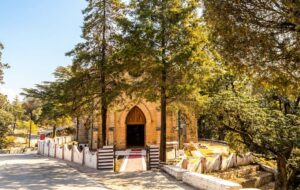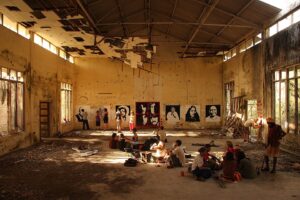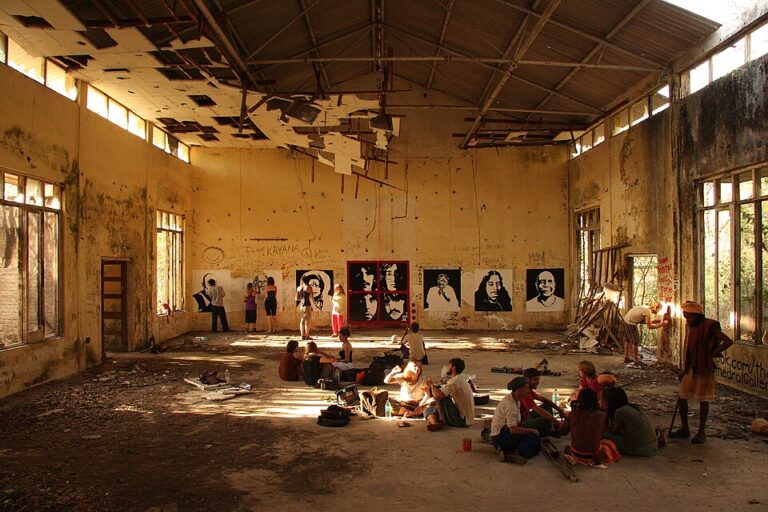Discover Khari Baoli: Old Delhi’s 400-Year-Old Spice Market (Location, History & Tips)
Khari Baoli is not just a market — it’s a living museum of Indian spice trade, culture, and history. Tucked into the lanes of Chandni Chowk in Old Delhi, Khari Baoli is widely regarded as Asia’s largest spice market and has been a centre of commerce since the 17th century. This guide covers the history, what to expect, how to get there, photography tips, and practical advice so you can explore Khari Baoli like a pro.
A Short History — From Stepwell to Spice Empire
The name Khari Baoli literally hints at its past: baoli means stepwell and khari/khara refers to salty water. While the original salty stepwell has long since vanished, the area transformed during the Mughal era into a bustling trading hub. Established around the mid-1600s near Fatehpuri Masjid and Chandni Chowk, Khari Baoli grew into a wholesale spice centre that supplies markets across North India. Many shops here have been family-run for generations — some now in their ninth or tenth generation — preserving centuries of trade knowledge.
Old Delhi Spice Market

Why Visit Khari Baoli (What Makes It Special)
-
Aromatic Overload: Rows of cumin, coriander, turmeric, asafoetida (hing), masala blends, and dozens of chilli varieties.
-
Wholesale Scale: Massive sacks, old-school weighing scales, and a trade rhythm that survives industrialisation.
-
Living Traditions: Porters, grinders, picklers, and stallkeepers continue age-old practices.
-
Cultural Photographs: A spectacular sensory tableau for photographers and storytellers.
-
Rooftop Views: Gadodia Market rooftop gives panoramic views of the spice lanes and Old Delhi skyline.
What You’ll See & Buy
-
Whole and ground spices (cardamom, cinnamon, saffron, chillies, cumin)
-
Dried fruits & nuts (pistachios, almonds, raisins)
-
Teas, rice, and lentils
-
Asafoetida (hing) in multiple grades and forms
-
Traditional achars (pickles) and jaggery (gur)
-
Ayurvedic herbs and rare cooking ingredients
Tip: Many shops offer small sample packets for tourists; bargaining is expected for larger buys.
Suggested Read: Delhi versus New Delhi: Top tour places and attractions
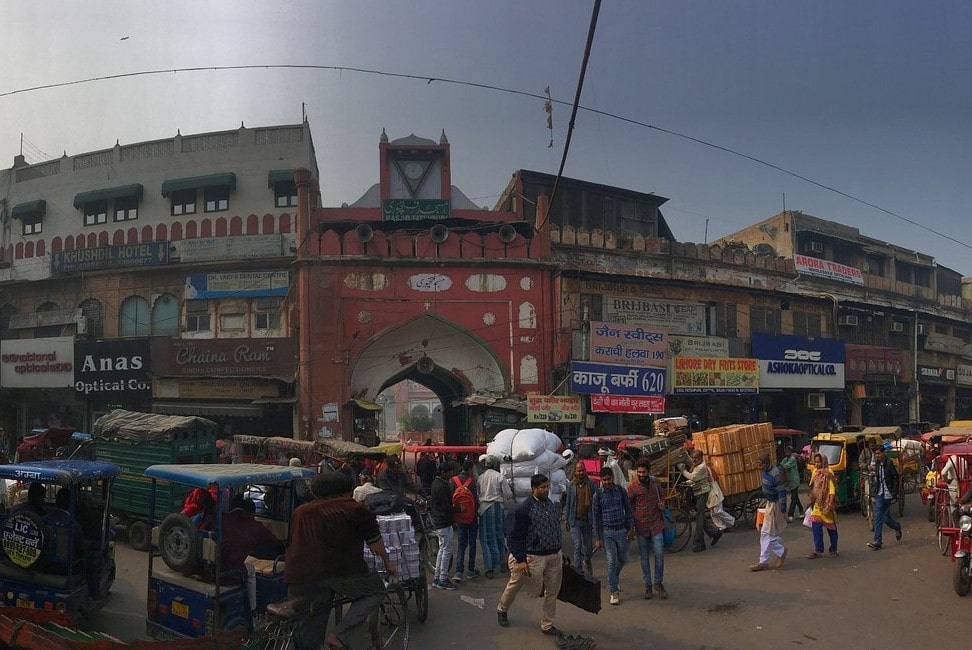
The Gadodia Market & Rooftop Perspective
At the heart of the market is the Gadodia Market complex — an old building where most wholesale action centres. Climb to the rooftop (with a local guide or by asking permission at specific shops) for one of the best vantage points in Old Delhi: minarets, narrow lanes, and a patchwork of spice sacks make stunning sunrise or golden-hour photos.
How to Get There (Practical Directions)
-
Metro: The nearest stations are Chandni Chowk (Yellow Line) — about a 10–15 minute walk — and Chawri Bazaar.
-
By Rickshaw: A typical option from nearby landmarks like Jama Masjid or Red Fort.
-
On Foot: If you’re exploring Chandni Chowk, it’s an easy walking detour.
Typical opening hours: Most shops operate roughly from 11:00 AM to 7:00/9:00 PM (hours can vary). Weekdays are busy but quieter mornings are best for photography and sampling.
Safety & Etiquette Tips
-
Watch your belongings: Crowds and narrow lanes make pickpocketing possible. Keep valuables secure.
-
Go with a guide if possible: A local guide speeds navigation, points out authentic shops (e.g., Mehar Chand & Sons), and helps with purchases.
-
Ask before photographing people or shops. Many vendors are happy to be photographed if asked politely.
-
Avoid peak heat: Visit in cooler months (November–February) or early morning/late afternoon.
-
Sample, don’t over-buy: Small sample packs are easier to carry and pass through customs if you’re traveling internationally.
Quick Facts (At a Glance)
-
-
Where: Chandni Chowk, Old Delhi (near Red Fort & Fatehpuri Masjid)
-
Nearest Metro: Chandni Chowk (Yellow Line) / Chawri Bazaar
-
Best time to visit: November–February; early morning or late afternoon
-
Famous for: Spices, dried fruits, Asia’s largest spice market, Gadodia Market rooftop
-
Suggested Read: Delhi to Agra Day Trip by High Speed Train: Learn how to book?
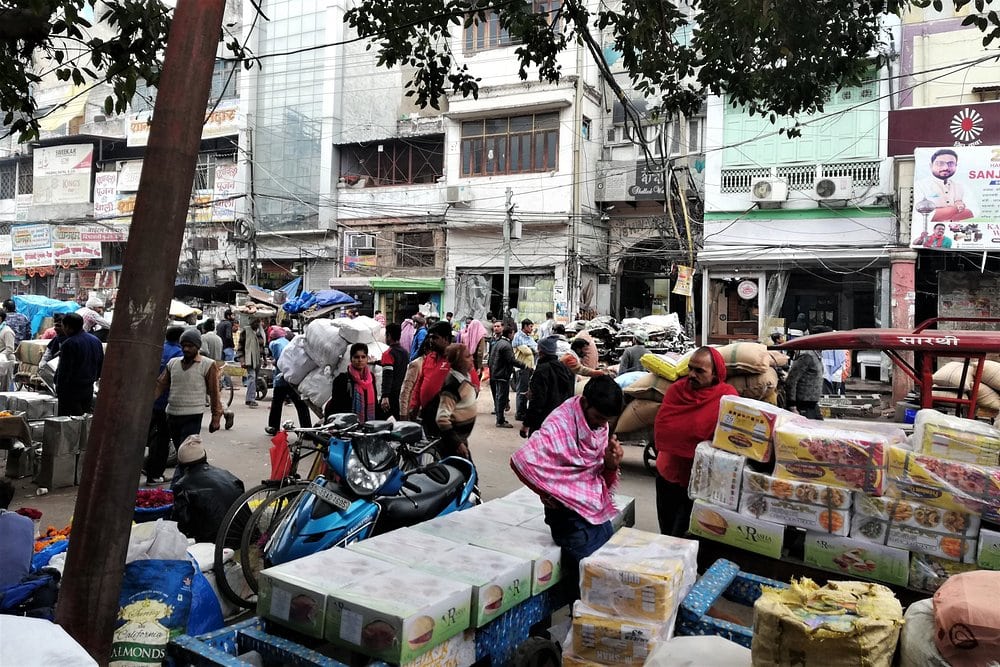
Photography Tips
-
Sunrise & golden hour from the Gadodia rooftop gives the softest light and fewer crowds.
-
Focus on details: heaps of saffron, rows of chillies, and the hands of porters make intimate, compelling images.
-
Candid portraits: capture the rhythm—laden carts, weighing scales, and bargaining faces.
-
Staged photos: many “Instagram setups” are staged; if you want authenticity, ask vendors to show their daily work.
Nearby Attractions (Make It a Half-Day in Old Delhi)
-
Chandni Chowk — shopping, street food, and narrow historic lanes.
-
Jama Masjid — grand mosque with sweeping views from its minaret.
-
Red Fort — UNESCO site and Mughal landmark.
-
Paranthe Wali Gali — famous lane for stuffed parathas and street food.
Final Thoughts: A Living Legacy
Khari Baoli is more than a market — it’s an active chapter of India’s culinary and commercial history. The scents, colours, and human energy here are unmatched: visiting is equal parts shopping, learning, and storytelling. Whether you’re a cook hunting for authentic ingredients, a photographer seeking raw city life, or a curious traveler, Khari Baoli offers a sensory pilgrimage you’ll remember long after you leave.
Suggested Read: New Delhi to Agra Taj Mahal: How to Travel by Train, Bus, and Car?
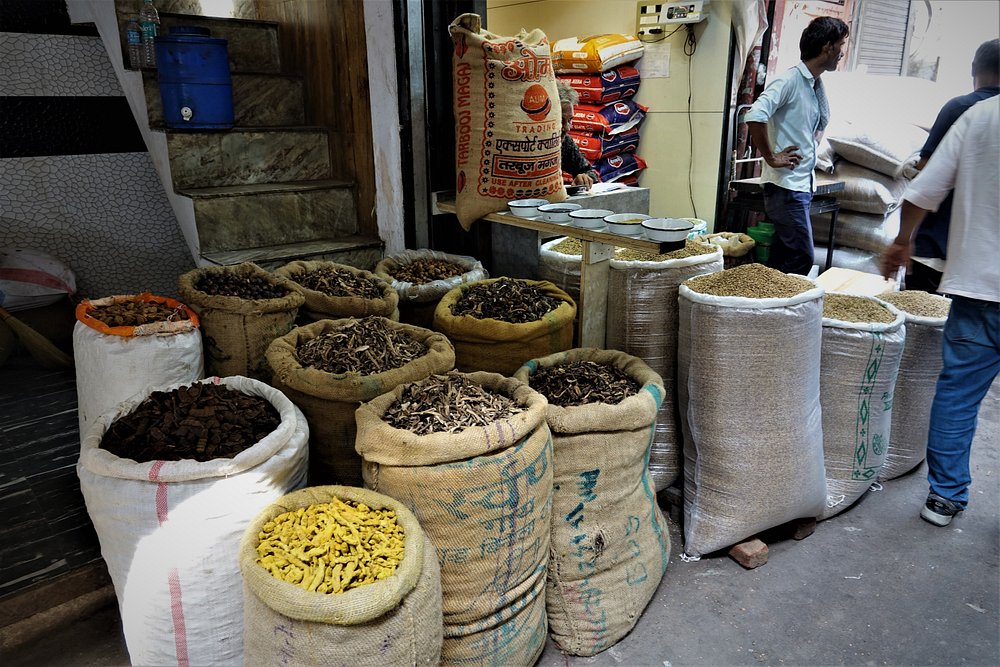
How to get to the Old Delhi Spice Market
The easiest way to reach Khari Baoli is via Delhi Metro. The nearest metro stations are:
- Chawri Bazaar (on the Yellow Line) Old Delhi Spice Market
- Chandni Chowk (also on the Yellow Line) Old Delhi Spice Market
To visit the spice market in Delhi, head to Khari Baoli, which is easily accessible thanks to Delhi’s well-connected public transport system.
Khari Baoli Market nearest Metro
The closest metro station is Chandni Chowk on the Yellow Line, from which it’s a 15-minute walk to the market. Khari Baoli operates from 11 AM to 9 PM, seven days a week, providing plenty of time to explore its bustling streets filled with aromatic spices.
This market is not just the largest in India but in all of Asia, and it’s a must-see for any traveler in Delhi. No trip to the city would be complete without experiencing the vibrant, sensory overload of its famous spice market.
Additional Information: Old Delhi Spice Market
- Location: Near Red Fort, Delhi-6 Old Delhi Spice Market
- Nearest Metro Station: Chandni Chowk Old Delhi Spice Market
- Opening Hours: 11 AM to 9 PM Old Delhi Spice Market
- Famous For: Spices, dry fruits, dry plums, rice, grains, and mulberries
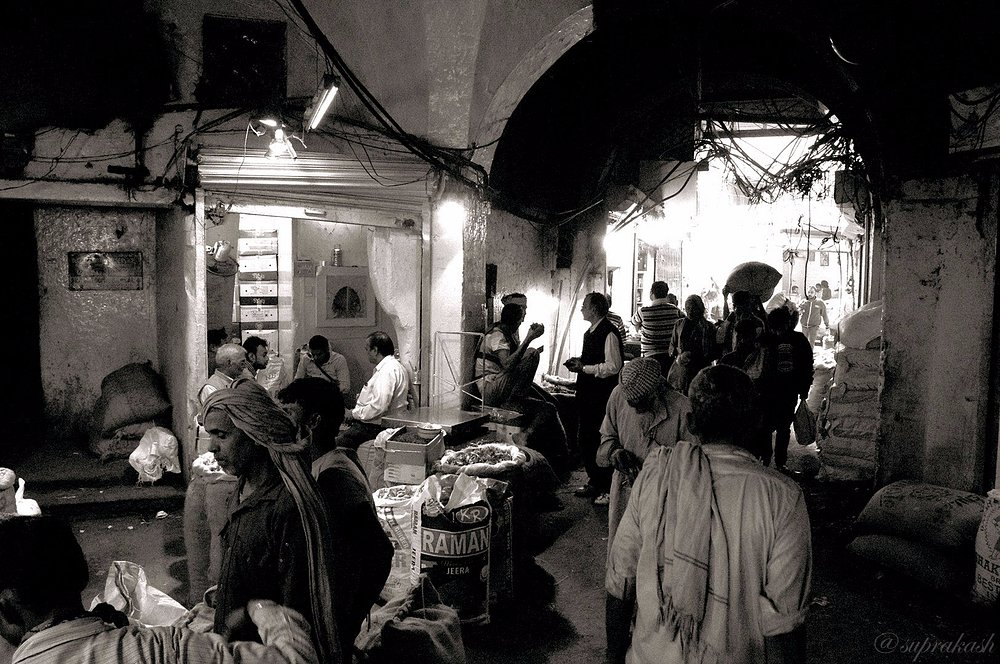
Khari Baoli: The Heart of Asia’s Largest Spice Market
At the core of Khari Baoli lies the historic Gadodia Market building, which serves as the epicenter of Asia’s largest spice market. The market has become a livelihood for many, particularly for the spice porters, most of whom are former farmers.
These porters hail from regions as far as Jammu and Kashmir, Madhya Pradesh, and Rajasthan. After farming work dwindled, many of them migrated to Old Delhi, following in the footsteps of generations of family members who came before them.
For these porters, Khari Baoli is not just a workplace but also a home. They spend their days carrying heavy sacks of herbs, seeds, and spices on their backs, moving them in and out of the bustling Gadodia Market.
A Sensory Overload: Old Delhi Spice Market:
As porters discard each sack, a fine cloud of spice dust and dirt fills the air, immediately engaging your senses. The mix of aromas is so complex and diverse that it’s hard to pinpoint any single smell. Instead, the market’s narrow corridors carry a musty but heady odor—a smell that is unmistakably Indian.
This unique blend of scents, along with the lively atmosphere, makes Khari Baoli an experience that stays with you long after you leave. It’s more than a market—it’s a window into India’s spice trade and the lives of those who sustain it
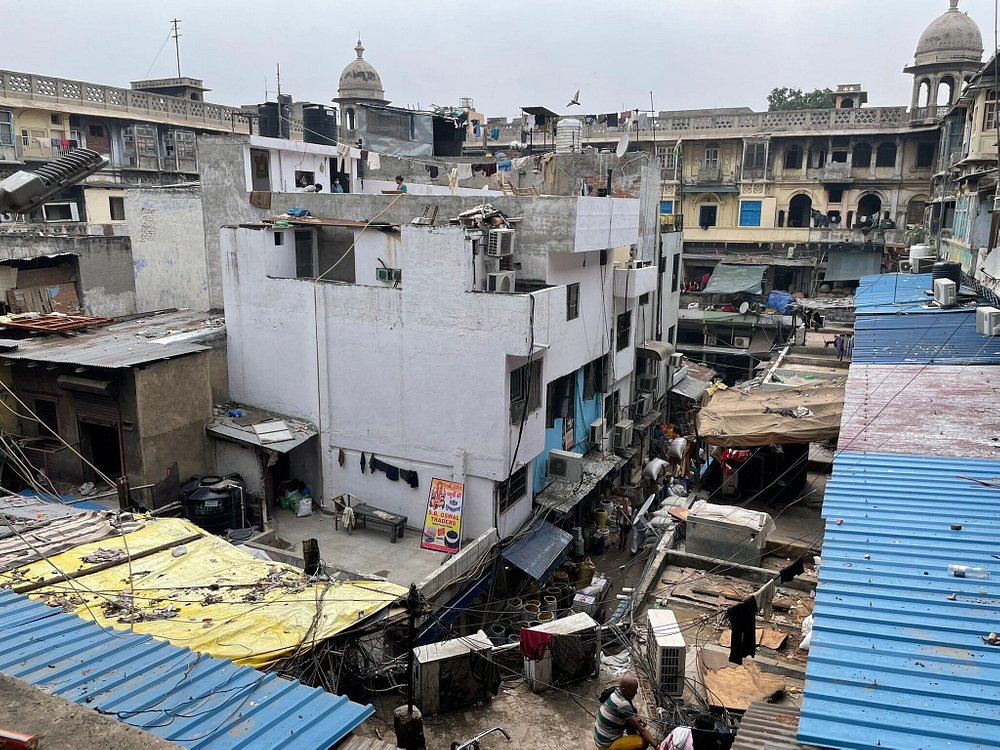
The Chaotic Energy
As you step out from the organized chaos of Khari Baoli into the uncovered alleyways at the back, a whole new scene unfolds. These narrow passages snake between apartment buildings, filled with labourers resting in tiled alcoves.
Some men relax, using wooden carts as makeshift beds, their hands behind their heads and eyes closed. Others are hard at work, loading these carts with heavy sacks and moving from store to store, keeping the spice trade alive.
A World Beyond Gadodia Market
Exiting through the wrought-iron archway of the Gadodia Market, you’re immediately hit by the intense atmosphere of Chandni Chowk. Porters unload trucks overflowing with leaves and spices, causing frustration for motorists caught behind the hustle.
Senses Overloaded: Smells, Sounds, and Sights of Old Delhi
Back in the dusty, dry heat, the smell of spices mixes with diesel fumes, perfume, and even the earthy scent of cow dung. But it’s not just your sense of smell that’s overwhelmed—the soundscape is equally intense.
The noise of 19 million people fills the air: traffic honking incessantly, unfamiliar music playing over the hum of daily life, and street vendors shouting to attract customers. The cacophony of sounds becomes so overwhelming that it eventually fades into a constant, deafening white noise.
Khari Baoli, with its mix of smells, sounds, and sights, offers a raw, immersive experience of Old Delhi that stays with you long after you’ve left.
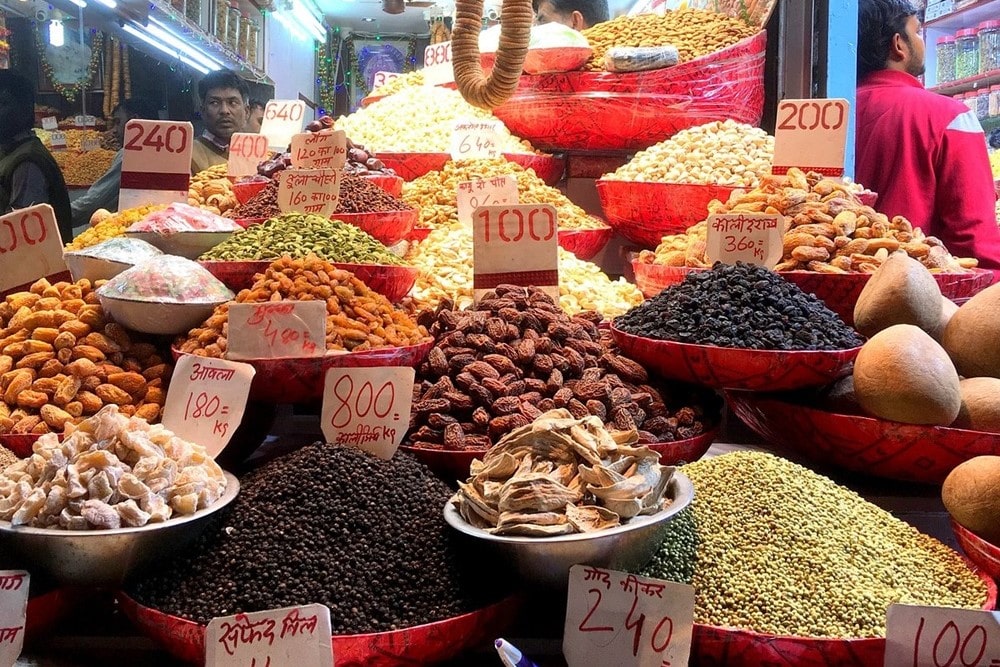
Exploring Old Delhi Spice Market:
For the unprepared traveler, Old Delhi can feel like it’s swallowing you whole. The air is thick and suffocating, while the narrow, claustrophobic streets are packed with people, stray animals, and children.
Mopeds and rickshaws push through the crowds, their passengers often resigned to the chaos. Among this sea of humanity, tourists flit by—some wide-eyed in awe, others overwhelmed by the intense experience.
Yet, despite the bedlam, there’s a charm to it all, like stepping into Aladdin’s cave. The colors are mesmerizing—the vibrant spices, orange marigolds being strung into fragrant garlands, and sparkling bangles in every imaginable hue. Old Delhi, with its layered history, feels like a living organism, disorderly yet functioning seamlessly.
My Recommendation
Visiting the Old Delhi Spice Market Rooftop at sunrise is a fantastic way to capture the beauty of the city before it gets busy, but it’s crucial to hire a local guide to ensure your safety, especially in the early hours when Chandni Chowk can be unsafe and dark.
A knowledgeable guide or rickshaw driver can take you directly to the rooftop and ensure you find the Gadodia Market Complex with ease.
While many famous Instagram photos with vibrant blankets, cushions, and marigolds might appear spontaneous, these setups are often staged.
However, the views from the rooftop are naturally breathtaking, offering a unique, authentic glimpse of Old Delhi’s rooftops, minarets, and the bustling spice market below—without any artificial embellishments.
If you wish to create a similar photo setup, you can buy marigolds and blankets from local traders in Chandni Chowk, supporting the local economy while adding a personal touch to your photography.
Tips for Photography:
If you’re planning to visit Khari Baoli, I would recommend coming later in the morning when the market is fully operational. This is when you can experience the vibrant life, sounds, and scents that make the spice market so captivating.
The bustling activity, combined with the colorful spices, creates a rich tapestry perfect for portraits and photography. You’ll see vendors interacting with customers, and spices being weighed and bagged, capturing the true essence of Old Delhi.
- Best Time: Sunrise offers the soft morning light, creating stunning visuals.
- Guidance: Always have a local guide or rickshaw driver to navigate the area, especially for early morning visits.
- Authenticity: The views are striking on their own, but feel free to stage your own photos by sourcing materials from local traders.
This experience is ideal for those looking for a raw, cultural immersion in one of Delhi’s oldest markets.
What else is there to see in Old Delhi?
As well as the spice market, Chandni Chowk has an endless list of attractions that are on the heritage tourist circuit.
Chandni Chowk: A Historical and Cultural Melting Pot
Chandni Chowk, a bustling artery of Old Delhi, stretches from the Red Fort in the east to Jama Masjid, weaving together centuries of history. It’s a labyrinth of experiences—from Dariba Kalan, known for its silver jewelry, to the famed Paranthewali Gali, where hawkers have been selling parathas since the 1800s.
Built in 1653, Chandni Chowk is like peeling back the layers of an onion. Behind the grimy, 20th-century facades lie colonial mansions and centuries-old havelis. The past reveals itself in hidden courtyards and tucked-away temples that have weathered the centuries.
Jama Masjid: A Peaceful Island Amidst the Chaos
My journey leads me to Jama Masjid, Delhi’s largest mosque, built by Mughal Emperor Shah Jahan in 1644. The mosque, with its towering minarets and onion domes, can accommodate up to 25,000 worshippers.
As evening approaches, the city’s Muslim population pours into the mosque for prayers, navigating the narrow streets with purpose.
I quickly discard my shoes at the mosque’s steps and step onto the scorching red sandstone, now cool beneath the spray of workers attempting to combat the heat.
Inside the mosque’s 400-square-foot courtyard, people gather to pray, rest, and escape the city’s madness. Children run across the courtyard, while families relax on blankets, avoiding the hot stones. Though I am one of the few foreigners here, the welcoming energy is palpable.
A View from Above
Climbing the mosque’s minaret, I am rewarded with a breathtaking view of Delhi’s sprawl. Even from this vantage point, the city seems endless.
The streets of Old Delhi, which had consumed my afternoon, now appear as just a small part of this enormous tapestry. From above, the noise, the chaos, and the overwhelming scents blend into something quieter, almost serene.
Practical Information: Khari Baoli and Jama Masjid
- Khari Baoli: The spice market operates daily from 11 AM to 7 PM, except on Sundays. Tourists can buy small quantities of spices, though at a higher price than locals. The nearest metro station is Chandni Chowk on the yellow line, about a 15-minute walk from the market.
- Jama Masjid: Reach the mosque via Chawri Bazaar metro station. The mosque is open from 7 AM to sunset, but tourists should avoid prayer times (12:15 PM–1:45 PM and the half-hour before sunset).
- There is no entry fee, though cameras cost 200 rupees, and climbing the minaret is an extra 100 rupees. Dress conservatively, covering ankles and arms; otherwise, you will be given a covering. Carry a bag for your shoes if you don’t want to leave them outside.
Other Things to See in Old Delhi:
Red Fort:
Built by Emperor Shah Jahan, this magnificent fort was the seat of Mughal power. Today, it’s a UNESCO World Heritage Site and a symbol of India’s independence, where the Prime Minister addresses the nation every Independence Day.
Famous Food Spots:
-
- Karim’s: A legendary restaurant, famous for its goat curry.
- Kuramel Kulfi Wala: Known for delicious kulfi (Indian ice cream).
- Jain Coffee House: Try their famous sandwiches. Old Delhi Spice Market
- Shyam’s Sweets: Considered to serve the best samosas in the area.
Haveli Dharampura:
A beautifully restored haveli with a rooftop restaurant that offers panoramic views of Jama Masjid and Chandni Chowk. Old Delhi Spice Market
Exploring Old Delhi:
To avoid feeling overwhelmed, a guided tour is a great idea. There are various options such as:
- Heritage walking tours of Old Delhi to soak in the culture and history.
- Rickshaw rides to navigate through the chaotic streets easily. Old Delhi Spice Market
- Cycle tours to see Old Delhi wake up in the morning as vendors prepare their stalls.
This combination of history, culture, and authentic street life makes Old Delhi an unforgettable experience!
Old Delhi Spice Market Old Delhi Spice Market Old Delhi Spice Market Old Delhi Spice Market Old Delhi Spice Market Old Delhi Spice Market Old Delhi Spice Market Old Delhi Spice Market Old Delhi Spice Market Old Delhi Spice Market


